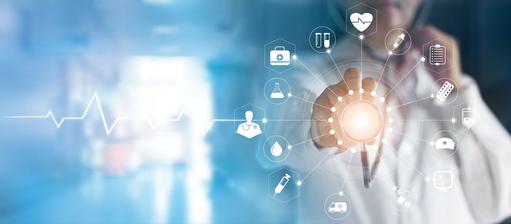- Misdiagnosis means unnecessary suffering and the loss of life
- 15% of all medical cases are misdiagnosed
- 44% of some types of cancers are misdiagnosed
- Misdiagnosis results from the way doctors are trained
Can AI reduce medical misdiagnosis?
Inaccurate or delayed medical diagnosis is more widespread than often thought, and results in a staggering toll of harm and patients’ deaths.
Unnecessary suffering
Each year, in the US an estimated five per cent of all medical cases are misdiagnosed. ‘Not bad’, some might say given the millions of Americans who visit their doctors’ each year presenting thousands of different disease states each with multiple symptoms. But five per cent translates to 12 million annual misdiagnoses in the US alone, which is, “the tip of the iceberg” according to Professor Graham Neale, an expert in misdiagnosis from the Centre for Patient Safety and Service Quality at Imperial College London.
A 2012 study reported in The American Journal of Medicine suggests that 15% of all medical cases in developed economies are misdiagnosed. Professor Neale suggests that 15% of all UK cases are also misdiagnosed. The Mayo Clinic Proceedings suggest that misdiagnosis could be as high as 26%, and according to The Journal of Clinical Oncology, a staggering 44% of some types of cancers are misdiagnosed.
Misdiagnosis means unnecessary suffering, the loss of life, and unnecessary costs. For example, 33% of the $3trillion spent each year on healthcare in the US is considered “wasted” because of medical misdiagnoses. And data released in 2015 by NHS England’s Litigation Authority in response to a Freedom of Information request show compensation paid to people misdiagnosed rose from £56 million in 2009-10 to more than £194 million in 2013-14.
According to Sebastian Lucas, former Professor of Clinical Histopathology at King’s College London, the most common misdiagnosis found through post-mortem examinations are the over diagnosis of cardiac disease, the under diagnosis of pulmonary-embolism, the over and under diagnosis of cancer, and the under diagnosis of significant infections.
 What are the most common misdiagnosis found through autopsy? By Sebastian Lucas What are the most common misdiagnosis found through autopsy? By Sebastian Lucas
Medical misdiagnosis occurs when either a condition is undiagnosed, or where an incorrect diagnosis is made. An example of the former is when a patient with a health problem has visited their doctor over a period, and the doctor fails to diagnose the illness. An example of the latter is when, say, a fracture is diagnosed as a sprain.
Why misdiagnosis occurs Reasons given for misdiagnosis include the fragmented nature of healthcare systems, and the over burdened, demoralised and scarce supply of primary care doctors. See, Curing the Problems of General Practice. In 2008 Eta Berner and Mark Graber published a paper in the American Journal of Medicine entitled, ‘Diagnostic Error: Is Overconfidence the Problem?’ which suggests that both intrinsic and systemically reinforced factors lead doctors to be over confident in their ability to diagnose, and once a diagnosis is made and a treatment pathway started, a momentum occurs, which is difficult to change.
Doctors trained to take short cuts
At the root of misdiagnosis is the way that doctors are trained, says Jerome Groopman, Professor of Medicine at the Harvard Medical School, and Chief of Experimental Medicine at Beth Israel Deaconess Medical Center.
Groopman’s thesis is predicated on the concept of the availability heuristic developed by Nobel Laureate Daniel Kahneman, notable for his work on the psychology of judgment and decision-making. In his book How Doctors Think, Groopman suggests that doctors are trained to recall similar recent cases when making a diagnosis. For example, common infections picked up by children at school often affect entire communities. Once a doctor has seen, say, nine such cases, the information about them is immediately available in his subconscious, and creates a tendency for the tenth patient presenting similar symptoms to be diagnosed the same although the actual illness might be different.
Such mental shortcuts are indispensible in a medical setting. In A&E, for example, doctors are encouraged to use mental shortcuts to help them make rapid decisions often on incomplete information; failure to do so could mean the difference between life and death.
Will misdiagnosis increase?
Structural reasons suggest that misdiagnosis will not be reduced in the near term. According to the Royal College of General Practitioners the shortage of doctors in the UK is the worst it has been for 40 years. Established GPs are retiring early, and a significant proportion of newly qualified GPs are moving abroad where pay and working conditions are better. One hundred primary care practices, serving 700,000 patients across Britain, are facing closure, and the number of doctor-patient consultations is estimated to rise from 338 million in 2013 to 441 million by 2017.
Similarly in the US, the Association of American Medical Colleges predicts increasing shortages of doctors: 130,600 by 2025. One reason for the shortage is the aging of both doctors and their patients. According to a 2012 Physicians Foundation survey, nearly half of the 830,000 doctors in the US are over 50, and approaching retirement.
Thus, fewer doctors in both the UK and US face having to diagnose an increasing number of aging patients presenting complex conditions, at a time when the volume of medical data are doubling every 73 days. Under such conditions it seems reasonable to assume that the incidence of misdiagnosis will not decrease.
Increased role for cognitive computers in medicine
Will the increased pressure on doctors to diagnose more accurately be helped by artificial intelligence (AI)? Although there are some challenges for AI in a medical setting, it is well positioned to play an increased role in diagnosis. This is confirmed by Google’s DeepMind AlphaGo computer’s landmark defeat of Lee Sedol, a 33-year-old grandmaster of the ancient Asian game GO in March 2016. Let us explain.
AI: the complex algorithms that analyze and transform electronic medical data, into clinically relevant medical opinions for health professionals has developed significantly as the demand for healthcare increased, healthcare costs escalated, and the supply of doctors decreased.

What is the next "big thing" in healthcare? By Devi Shetty The relationship between the game GO and medical diagnosis For some time, cognitive computers have been able to defeat the world’s best human players of games such as draughts and backgammon by enumerating every possible move, and drawing up rules for how to guarantee that a computer will be able to play to at least a draw. Although more complex, chess computers rely on a modified version of the same tactic. In 1997 for example, when IBM’s Deep Blue computer defeated former world chess champion Garry Kasparov, it could evaluate 200 million possible moves in a second. But GO is different: its simplicity belies its astonishing complexity. There are more legal board states for a game of GO than there are atoms in the universe, and just like in medical diagnoses, reaction and intuition are important. These intangible aspects of the game GO, and diagnosis, make them resistant to the tactic by which games in the past have been “solved” by computers. Experts predicted that it would take another 10 years before a computer program would stand a chance even against a weak GO player. This is why a computer’s defeat of Lee Sedol, signaled a landmark moment for AI, and has implications for medical diagnosis.
GOis played by two people on a 19-by-19 grid-board, with 361 black and white stones, 181 black and 180 white. Each player takes turns placing their stones in an attempt to surround and capture their opponent’s pieces. The player who controls more territory is the winner. The first move of a game of chess offers 28 possibilities; the first move of a game of GO can involve placing the stone in one of 361 positions. An average game of chess lasts around 80 turns, while on average GO game lasts for some 150 turns, which leads to a staggering number of possibilities.
Cognitive computing and diagnosis
Cognitive computing systems that understand, reason, and learn, also are able to see health data that were previously hidden, and do more than we ever thought possible. Doctors have access to such computers, which provide them with collective knowledge gathered from thousands of healthcare providers, millions of patients’ records, and millions of treatments other doctors have prescribed to people presenting similar symptoms and disease states. Such computers are capable of analyzing in seconds these data and identifying patterns that humans cannot.
Further, unlike doctors, computers work 24-7, 365 days a year, they never get tired or demoralised, and they never leave. Also, computers are faster and more thorough than doctors, and can analyse vast amounts of patient data, identify trends in seconds and consistently make more accurate diagnoses. One example is IBM’s Watson, a computer, already being used in medicine, which can attain high levels of cognitive behaviour. Watson uses natural language processing to analyse structured and unstructured data common in clinical notes and reports, and can read 40 million medical documents in 15 seconds, understand complex questions, and identify and present evidence based solutions and treatment options. In the US similar computer programs have stopped making clinical recommendations based on the most popular therapies prescribed by its users, to providing doctors with clinical recommendations based on patient outcomes.
Challenges for AI in medical diagnosis
Despite the fact that AI systems are getting smarter there are still significant challenges associated with the compatibility of computer systems, the integrity of medical data; and data security and access. Further, as AI systems get smarter so the line between computers recommending and deciding becomes blurred. Healthcare providers are wary not to allow their AI systems to make clinical decisions because this would mean that they would be viewed as “medical devices”, and require FDA approval, which can be a costly and lengthy process to obtain.
Doctor’s resistance to AI systems
A doctor’s raison d'être has been to diagnose and treat illnesses, which ordinary people cannot do because it requires expertise, intuition and interpersonal skills. Some doctors argue that computers will never be able to provide such skills. But medical knowledge, which previously resided in the minds of the few doctors, has become readily available to everyone over the Internet, and doctors have changed from being the sole processors of that knowledge, to being the interpreters of such knowledge; in this scenario AI has an important role.
Takeaway
Professor Stephen Hawking and other leading scientists have warned of the dangers of AI becoming “too clever”. There are also concerns about data security and privacy, and some doctor’s fear cognitive computers could diminish their role. However, the defeat of Lee Sedol by AlphaGo has demonstrated that computers can attain high levels of intelligent behavior, and this has significant implications for medicine in general and diagnoses in particular.
.
|



